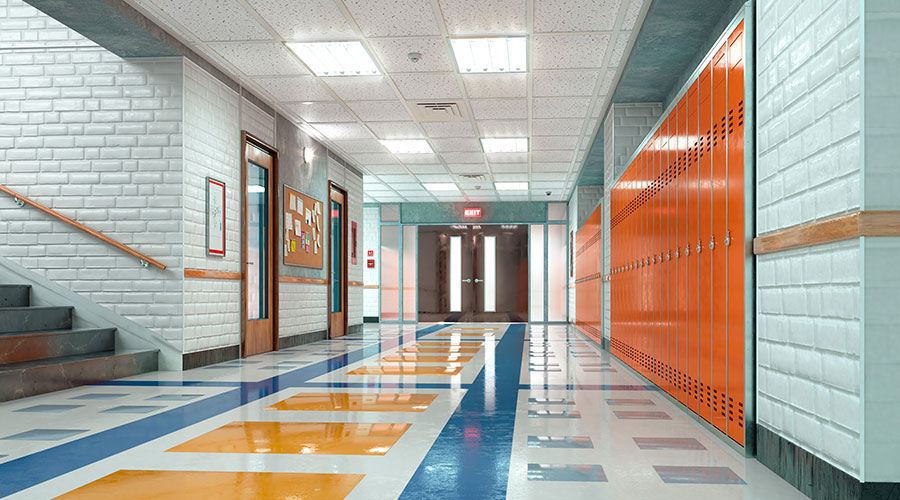Supporting Human Health With Circadian Lighting Design
To support health and wellness, make sure lighting is designed thoughtfully to enhance occupant health and wellness.
Our bodies are tuned to operate optimally under the natural cycle of bright daylight during the day and inky darkness at night. But many Americans these days are exposed to unnatural light conditions. Since the late 1980s, we spend at least 90 percent of our time indoors, according to studies done by the U.S. EPA. Much of that time we are bathed in artificial light, especially at night when it is most detrimental. Among the results is a disruption to our circadian rhythms, which can lead to a range of negative effects to our bodies and minds.
The lighting industry is working to rectify the situation with lighting and lighting design that can provide a beneficial health outcome by supporting the circadian system. With the refinement of LEDs, it is now possible to install luminaires that can pour out lumens, finely tuned to a range of color temperatures. But supporting human health with artificial lighting is a nuanced proposition, with several implications facility managers should be aware of, such as the relationship with energy consumption.
Standardization of circadian design
As the understanding around the human circadian system has grown, organizations have been able to start codifying the strategies needed to support circadian system entrainment in the built environment. In the last two years, several guidance documents prescribe the necessary performance attributes of lighting systems for human health benefit. These include WELL v2 Q2 2019, UL Design Guideline 24480, and CHPS Core Criteria 3.0. In general, these systems specify how much light needs to be provided at the eye-level of facility occupants to trigger the circadian system. This differs from what code requires for general illumination.
With these guidance documents in place, it is possible to start to understand the implications for facility management of these lighting designs. Researchers at Pacific Northwest National Laboratory (PNNL) are learning more about the impacts of circadian lighting design on energy consumption. In a preliminary study, researchers modeled the energy consumption impacts in an office space and a classroom meeting the circadian lighting design requirements of the three above mentioned guidelines.
The researchers only considered an overhead lighting system with recessed luminaires and did not include variables such as daylight from windows in the model (that study is coming out later this year) or individually controlled lighting at each workstation. In general, the researchers found that making the overhead lighting system do all the work of achieving a circadian entrainment benefit results in much more energy use over code. “Energy use may increase between 10 percent and 100 percent because of increased luminaire light levels used to meet circadian lighting design recommendations,” according to the report, Energy impact of human health and wellness lighting recommendations for office and classroom applications, published in Energy & Buildings. Again, not accounting for other light sources, such as sunlight, was an artificial constraint created in the model to explore the dynamics of only using overhead recessed lighting for circadian system entrainment.
The increased energy usage had already been noticed in earlier PNNL field studies, but one finding from the PNNL models was how much the reflectance values of the surfaces in the space mattered. A room has six major surfaces which can absorb or reflect light, as well as numerous finishes on furniture elements, and it is important to consider those factors. “The coloration and how those respond from a brightness appearance matters,” says Brian Stacy, principal at Arup. Facility managers should consider what’s in the field of view, in particular the larger vertical surfaces, he says.
Field of view, or orientation to the light source, has a strong impact. “If your desk has a view of daylight, you’ll have a better chance of meeting those metrics,” says Sarah Safranek, senior associate lighting research engineer at PNNL.
This points to the primary factor of a successful circadian design: daylight. Though the PNNL study looked at only the overhead lighting system, that is not the real-world starting point. “Our first approach would be to let daylight lead,” says Stacy. The lighting system would then boost what’s there naturally, he says. Prioritizing daylight and daylight harvesting also boosts the energy efficiency of the design.
“If you’re going to focus on human-centric lighting, you cannot have that conversation without daylight,” says Michael Barber, principal at The Lighting Practice. A corporate office project he worked on recently had a goal of meeting WELL’s circadian lighting criteria by any means necessary. And even with a very well-designed space the lighting system couldn’t meet the criteria without the inclusion of daylight, he says.
Another factor to consider is how to best deliver light to the eye. “Local lighting is the key,” says Rae. Nobody spends their workday staring at the ceiling, at least not all day. A diffuse light source at the eye at the workstation is going to have the most benefit out of an electric lighting strategy, he says. “You have to think about the most efficient way that you can get light to the eyes without creating glare.”
Related Topics:













